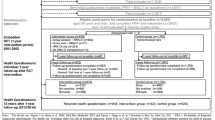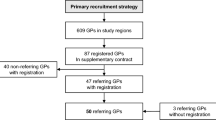Abstract
Background and aims: Preventive home visits were introduced by legislation in Denmark in 1998. This ongoing randomized controlled intervention study introduces a model where preventive home visits to elderly people are carried out in a standardized way, focusing on early signs of disability and on physical activity. The study includes general practitioners (GPs) in relevant parts of the assessment and endeavors coordinated interdisciplinary follow-up. Our main aim was to investigate whether this model gives enhanced active life expectancy, but the focus of the present paper is the design of the study. Methods: The design was a prospective, controlled, follow-up study conducted over a 3-year period (1999–2001) with randomization and intervention at the community level, and outcomes measured at an individual level among people living in those communities. The study included 17 pairs of intervention and control communities (34 in total), including 2104 persons aged 75–80 years in the intervention communities (participation rate, 70.8%) and 1956 persons in the control communities (p.r. 70.3%). The main outcome measure is change in functional ability after 1.5 and 3 years. Other outcomes are mortality, and hospital and nursing home admissions. Intervention communities received systematic education and written materials; two key representatives from each community also attended bi-annual follow-up meetings. Control communities did not receive any intervention but were allowed to conduct a preventive program completely on their own. Results: Baseline characteristics were similar in the intervention and control communities with regard to size, rural and urban characteristics and geriatric services, and the individual characteristics of participating persons living in these communities were also comparable. The intervention was well accepted and feasible. Conclusions: When results become available, the study should reveal the most important factors for preventive home visits to elderly people.
Similar content being viewed by others
References
Hendriksen C, Lund E, Stromgaard E. Consequences of assessment and intervention among elderly people: a three year randomized trial. BMJ 1984; 289: 1522–4.
Fabacher D, Josephson K, Pietruszka F, Linderborn K, Morley JE, Rubenstein LZ. An in-home preventive assessment program for independent older adults: a randomized controlled trial. J Am Geriatr Soc 1994; 42: 630–8.
van Rossum E, Frederiks CMA, Philipsen H, Portengen K, Wiskerke J, Knipschild P. Effects of preventive home visits to elderly people. BMJ 1993; 307: 27–32.
Pathy MSJ, Bayer A, Harding K, Dibble A. Randomized trial of case finding and surveillance of elderly people at home. Lancet 1992; 340: 890–3.
Stuck AE, Siu AL, Wieland GD, Adams J, Rubenstein LZ. Comprehensive geriatric assessment: a meta-analysis of controlled trials. Lancet 1993; 342: 1032–6.
Elkan R, Kendrick D, Dewey M, et al. Effectiveness of home based support for older people: systematic review and meta-analysis. BMJ 2001; 323: 1–9.
Stuck AE, Egger M, Hammer A, Minder CE, Beck JC. Home visits to prevent nursing home admission and functional decline in elderly people. Systematic review and meta-regression analysis. JAMA 2002; 287: 1022–8.
Vetter NJ, Lewis PA, Ford D. Can health visitors prevent fractures in elderly people? BMJ 1992; 304: 888–90.
Stuck AE. Aronow HU, Steiner A, et al. A trial of annual in-home comprehensive geriatric assessments for elderly people living in the community. N Engl J Med 1995; 333: 1184–9.
Stuck AE, Minder CE, Peter-Wüest I, et al. Randomized trial of inhome visits for disability prevention in community-dwelling older people at low and high risk for nursing home admission. Arch Intern Med 2000; 160: 977–86.
van Haastregt JC, Diederiks JP, van Rossum E, de Witte LP, Crebolder HF. Effects of preventive home visits to elderly people living in the community: systematic review. BMJ 2000; 320: 754–8.
Rubenstein LZ, Stuck AE. Preventive home visits for older people: defining criteria for success. Age Ageing 2001; 30: 107–9.
Avlund K, Davidsen M, Schultz-Larsen K. Changes in functional ability from age 70 to 75: A Danish longitudinal study. J Aging Health 1995; 7: 254–82.
Avlund K, Damsgaard MT, Schroll M. Tiredness as determinant of subsequent use of social and health services. J Aging Health 2001; 13: 267–86.
Avlund K, Damsgaard MT, Sakari-Rantala R, Laukkanen P, Schroll M. Tiredness in daily activities among non-disabled old people as determinant of onset of disability. J Clin Epidemiol 2002; 55: 965–73.
Podsiadlo D, Richardson S. The Timed “Up and Go”: A test of basic functional mobility for frail elderly persons. J Am Geriatr Soc 1991; 39: 142–8.
Hendriksen C, Vass M. Preventive home visits to elderly people — why and how. Frederikshavn: Dafolo, 1997 (in Danish).
Williams IE, Junius U, Jones D, Fischer G, Sandholzer G, Vass M. An evidence-based approach to assessing older people in primary care. The Royal College of General Practitioners, London, Occasional Paper 82, 2002.
Avlund K, Kreiner S, Schultz-Larsen K. Functional ability scales for the elderly. A validation study. Eur J Public Health 1996; 6: 35–42.
Avlund K, Thudium D, Davidsen M, Fuglsang-Sørensen B. Are self-ratings of functional ability reliable? Scand J Occup Ther 1995; 2: 10–6.
Avlund K, Holstein BE, Mortensen EL, Schroll M. Active life in old age. Combining measures of functional ability and social participation. Dan Med Bull 1999; 46: 345–9.
Pearsson TA, Wall S, Lewis C, Jenkins PL, Natziger A, Weinehall L. Dissecting the “black box” of community intervention: Lessons from community-wide cardiovascular disease prevention programs in the US and Sweden. Scand J Public Health 2001; 29(Suppl. 56): 69–78.
Donner A, Klar N. Statistical considerations in the design and analysis of community intervention trials. J Clin Epidemiol 1996; 49: 435–9.
Koepsell TD, Martin DC, Diehr P. Data analysis and sample size issues in evaluations of community-based health promotion and disease prevention programs: A mixed-model analysis of variance approach. J Clin Epidemiol 1991; 44: 701–13.
Avlund K, Due P, Holstein BE, Sonn U, Laukkanen P. Changes in household composition as determinant of changes in functional ability among old men and women. Aging Clin Exp Res 2002; 14(Suppl. to No. 3): 65–74.
McCullagh P. A logistic model for paired comparisons with ordered categorical data. Biometrika 1977; 64: 449–53.
Esbjerg S. Power-calculation and cluster-randomization. Internal Report I. Department of Biostatistics, University of Copenhagen, 1997 (in Danish).
Avlund K, Vass M, Jepsen E. Preventive home visits to older people in Denmark. Was functional status different in early and late responders and non-responders? Nordic Gerontological Congress, Iceland 2000 (Abstract).
Stuck AE, Walthert JM, Nikolaus T, Büla CJ, Hohmann C, Beck JC. Risk factors for functional status decline in community-living elderly people: a systematic literature review. Soc Sci Med 1999; 48: 445–69.
Stuck AE, Zwahlen HG, Neuenschwander BE, Schweizer RAM, Bauen G, Beck JC. Methodologic challenges of randomized controlled studies on in-home comprehensive geriatric assessment: The EIGER project. Evaluation of In-Home Geriatric Health Visits in Elderly Residents. Aging Clin Exp Res 1995; 7: 218–23.
Author information
Authors and Affiliations
Corresponding author
Rights and permissions
About this article
Cite this article
Vass, M., Avlund, K., Hendriksen, C. et al. Preventive home visits to older people in Denmark: Methodology of a randomized controlled study. Aging Clin Exp Res 14, 509–515 (2002). https://doi.org/10.1007/BF03327352
Received:
Accepted:
Published:
Issue Date:
DOI: https://doi.org/10.1007/BF03327352




